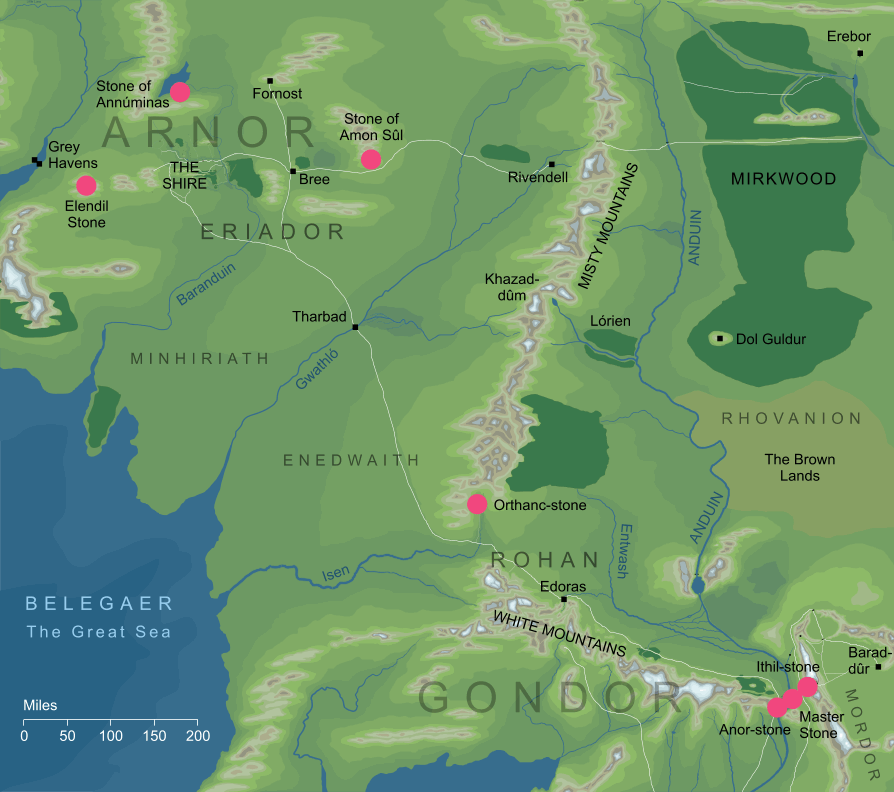- Cities and buildings
- Fields, plains and deserts
- Forests
- Hills and mountains
- Islands and promontories
- Lands, realms and regions
- Rivers and lakes
- Seas and oceans


|
||||
|


Which personality type are you?
Take the Free mydiscprofile Personality Test to discover your core personality and your ideal job.   Which personality type are you? |
|
Dates
Made during the Years of the Trees; at least two survived into the Fourth Age
Locations
Amon Sûl, Annúminas, Elostirion, Minas Anor (later Minas Tirith), Minas Ithil (later Minas Morgul), Orthanc, Osgiliath, (these were the original locations of the Seeing-stones, but several were later moved; for full details see the entry for the Palantíri)
Origins
Made by Fëanor
Races
Division
Other names
|
Seeing-stonesA name for the palantíri
The original locations of the seven Seeing-stones of Middle-earth.
The original locations of the seven Seeing-stones of Middle-earth.
The powerful orbs known as the palantíri made in ancient days by the Elves in Aman, and indeed said to have been the work of Fëanor himself. In appearance they were dark, perfectly smooth globes of various capabilities and sizes; some were small and portable, others so huge that they could not be lifted by a Man. The Elves gave certain of these Stones to the Númenóreans, and seven of these Númenórean Stones were rescued from the Downfall of that island by Elendil and his sons. So these seven were brought to Middle-earth, and the Dúnedain set them up at distant points in their lands: at Amon Sûl, Elostirion and Annúminas in the north, and at Osgiliath, Orthanc, Minas Anor and Minas Ithil in the south. The chief Stone of the north was that of Amon Sûl, lost with Arvedui in the cold northern seas. The greatest of the southern Stones stood beneath the Dome of Stars in Osgiliath, and was lost during the Kin-strife. During the Third Age, three of the Stones were known to have been lost (Arvedui also had the Stone of Annúminas with him when he was lost at sea). The Ithil-stone was captured by Sauron and almost certainly destroyed in the Downfall of Barad-dûr,1 and the palantír of Elostirion in the Tower Hills was taken back into the West on the Ring-bearers' White Ship. At the beginning of the Fourth Age, then, there were just two Seeing-stones left in Middle-earth, the Anor-stone and the Orthanc-stone. The Seeing-stones of Middle-earth were not the only palantíri to exist. Many remained with the Elves in Aman, including the so-called Masterstone held in the Tower of Avallónë on Tol Eressëa. While the Elendil Stone was still kept in the Tower Hills, it was said to have a special relationship with the distant Masterstone, and it could look along the Straight Road to Tol Eressëa and the Undying Lands themselves. Notes
See also...Anor-stone, Black Stone, Dome of Stars, Elendil, Elves of Lindon, Eye of Barad-dûr, Eye of Mordor, House of the Stewards, Isildur, Master Stone, Masterstone, Misty Mountains, Orthanc-stone, Palantíri, Rhymes of Lore, [See the full list...] For acknowledgements and references, see the Disclaimer & Bibliography page. Original content © copyright Mark Fisher 1999, 2001-2002, 2013. All rights reserved. For conditions of reuse, see the Site FAQ. Website services kindly sponsored by Discus from Axiom Software Ltd.Need an individual professional DISC personality test for guidance with your career? Our personal DISC profiles have you covered! |